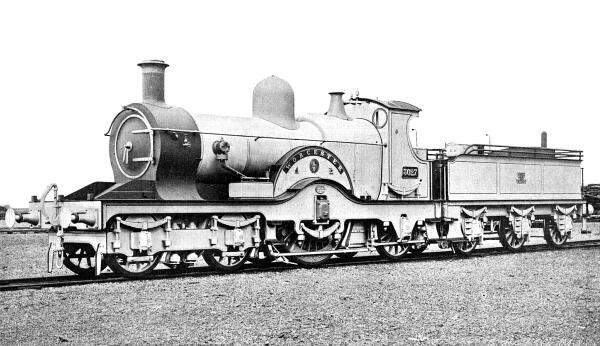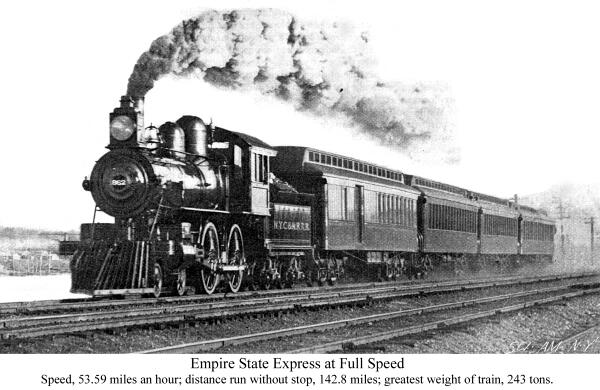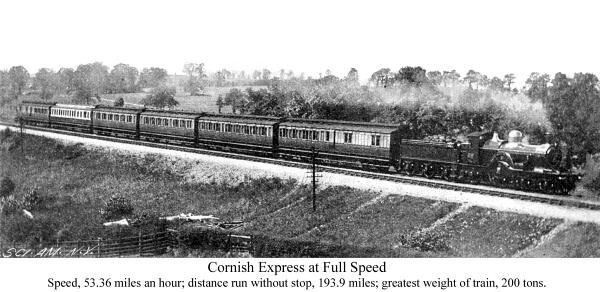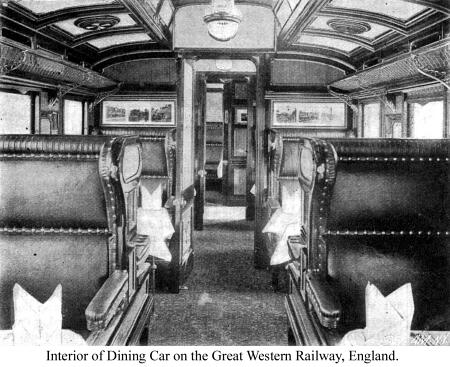THE TWO FASTEST LONG DISTANCE
RUNS WITHOUT STOP.
Scientific American—September 3,
1898
 The" Worcester"— The" Worcester"—
Typical English Express Engine.
Cylinders, 19x24
inches. Diameter of Drivers, 7 feet 8 inches. Weight of Engine,
107,520. Heating surface, 1,467 square feet. Boiler Pressure,
160 pounds.
 No. "999"— No. "999"—
Typical American Express Engine
Cylinders, 19x24 inches.
Diameter of drivers 7 feet 2½ inches. Weight of engine,
124,000 pounds. Heating surface, 1,930 square feet. Boiler pressure,
190 pounds.
It was during the ever memorable year of the Chicago Exhibition
that the New York Central and Hudson River Railroad opened the
present remarkable era of fast, long distance express trains.
Locomotive No. 999 and the Empire State Express are an old story
by this time, and its remarkable punctuality day in, day out,
is accepted as a matter of course by the public; but the famous
train, whatever higher speeds the future may have in store, will
always figure conspicuously in the annals of the world's railroads
as being the first to maintain a regular schedule speed of over
52 miles an hour for an unprecedented distance and for runs of
unprecedented length between stops.
We say this with all due deference to the splendid work which
had been done for several decades on the crack English roads,
where regular express trains, with a booked speed of about 50
miles an hour, had been running with great regularity; and where,
during the annually recurring summer competition, some scheduled
speeds of about 60 miles an hour had been maintained for trips
of over 400 miles. The regular trains, previous to the year of
which we speak, however, rarely ran further than about 70 miles
between stops, and the trains that were scheduled for 60 miles
an hour were literally "racing outfits," run for a few
weeks in the summer season, in the endeavor to secure or hold
the much coveted record from London to Aberdeen.
What gave the Empire State Express its world-wide celebrity
was its high average speed, the great distances (nearly 1,000
miles) over which this speed was maintained, and the great distances
covered by the train between stops—the first stage of the
journey, New York to Albany, 142.88 miles, at the rate of 53.58
miles per hour, being by far the longest scheduled run without
stop ever attempted. It was natural that the remarkable work done
by the New York Central should stimulate engineers in the home
of the "fast express," and of late years there has been
a gradual raising of the speed of a few crack trains on leading
English roads. The fastest long distance run without a stop in
Great Britain is now made on the Great Western Railway, the first
section of the Cornish Express covering the distance from London
to Exeter, 193.92 miles, at the rate of 53.36 miles per hour.
There is a popular impression that these crack expresses are
extremely light trains, hauled by powerful locomotives, and that
their running cannot therefore be taken as representative performances.
With a view to enabling the public to judge for itself, we have
gathered together in a more complete way than has ever been attempted
the engineering data of the two most famous long distance runs
without stop in the world.
 THE EMPIRE STATE EXPRESS.—In estimating
the merit of a locomotive performance there are numerous conditions
which must be known before we can determine its value. The mere
statement that a train ran at such a speed for such a distance
is of little value until the weight of the train, nature of the
road, and other qualifying conditions are known. THE EMPIRE STATE EXPRESS.—In estimating
the merit of a locomotive performance there are numerous conditions
which must be known before we can determine its value. The mere
statement that a train ran at such a speed for such a distance
is of little value until the weight of the train, nature of the
road, and other qualifying conditions are known.
The weight and power of the locomotive also are considerations
that greatly modify the merit of a fast run, and there are minor
considerations, such as the quality of the coal and, in a lesser
degree, of the water, that may have a telling effect one way or
the other upon the value of these phenomenal long distance speeds.
For the data regarding the Empire State Express we are indebted
to Col. Katte, chief engineer, and William Buchanan, the master
mechanic, of the New York Central Railroad, and the facts regarding
the English train have been communicated by J. C. Inglis, chief
engineer, and William Dean, locomotive superintendent, of the
Great Western Railway.
The Track.—The New York Central road, from New
York to Albany, is a tide-level line, running along the banks
of the Hudson River at an average elevation of 5 feet above mean
high water. Immediately after leaving the New York terminus, the
road climbs a slight summit of 53.7 feet; but at about 5 miles
from the starting point it reaches tide water and continues to
run at a practically dead level to Albany. The slight elevations
just before reaching Peekskill and at Poughkeepsie, where the
road is carried over elevations of about 35 and 30 feet, are the
only exceptions, the slight intermediate changes of grade being
due to bridges or a raising of the grade at the time the road
was built, to reduce the amount of excavation in rock cuttings.
Although the road is an easy one in respect of grades, it is full
of curvature, some of the curves being decidedly heavy for a fast
express service. The following table gives the degree and approximate
length of the curves from Spuyten Duyvil (where the road first
strikes the Hudson River and is well clear of New York city) to
Albany. The curvature in the city limits is even heavier than
that given in the table.
|
Curves of |
Total Length. |
|
7°32' |
1,000 feet |
|
7°15' |
700 feet |
|
5°00' |
2,035 feet |
|
4° to 3° |
2,084 feet |
|
3° to 2° |
4.25 miles |
|
2° to 1° |
23.00 miles |
|
1° and under |
10.00 miles |
There is a total of 29 miles of curvature of over 1° and
about 39 miles of total curvature, The. roadbed is probably as
fine as, and in some respects superior to, any in the world. The
first fifty miles are laid with steel weighing 100 pounds to the
yard. This is a very stiff rail, measuring 6 inches in height,
and the joints are fished with two long and heavy six-bolt angle
bars 40 inches in length. Ties are 6 inches deep by 8 inches wide
and 9 feet long, spaced 16 to the 30-foot rails, three ties being
bunched beneath each joint, one at each end of the angle bars,
and one under the center. Beyond Garrison's for the last 93 miles
the rails weigh 80 pounds to the yard and the angle bars are 36
inches long. Twelve inches of broken stone ballast is used throughout
the whole line.
T h e obstructions to fast running include road crossings at
grade, slow-ups for water, and reduced speed at bridge crossings.
The first 15 miles out of New York are run at considerably below
the average speed. From the Grand Central Station to Mott Haven,
5.3 miles, the speed is 31.8 miles per hour; the next 5.8 miles
to Spuyten Duyvil are run at 43.87 miles per hour; and the next
4 miles to Yonkers at 48.84 miles an hour. There are three slow-ups
to a speed of 25 miles for water, one at Montrose, 38.8 miles,
another at Hyde Park, 79.2 miles, and the third at Linlithgo,
108.3 miles from New York. The speed is also reduced in crossing
the Harlem River at New York and the long bridge at Albany, where
three minutes are consumed in crossing the Hudson River. Speed
is also slackened for curvature or crossings at Mott Haven, Yonkers,
and Hudson. With these detentions in mind, it can easily be understood
that many of the miles are run at from 60 to 70 miles an hour.
The Train.—The regular train consists of four cars
weighing 376,000 pounds; but it frequently happens that the heavy
special car of the vice-president, weighing 110,000 pounds, is
coupled on, and as the schedule time is kept with this load, we
feel justified in including it in this discussion of maximum performances.
The train is thus made up as follows:
|
|
Pounds. |
|
Buffet car |
94,000 |
|
Day coach |
82,000 |
|
Day coach |
97,000 |
|
Drawing room car |
103,000 |
|
Special car |
110,000 |
|
TOTAL |
480,000 |
The cars are 70 feet in length overall. They are carried on
six wheeled trucks, and have the vestibule connection, additional
steadiness being secured by a system of hydraulic buffers which
hold the cars closely together and greatly reduce the sway on
curves at high speed. The riding of the cars, we can state from
experience, leaves nothing to be desired, even on the sharpest
curves and at the maximum speeds.
The Locomotive.—The trains are hauled by a class
of 4-coupled 8-wheeled locomotives of which No. 999, illustrated
on our front page, is the best known example. The later locomotives
of this class differ chiefly from 999 in having 6½ instead
of 7 feet in diameter, and slightly less heating surface. The
dimensions of No. 999 are as follows: Cylinders, 19 by 24 inches;
diameter of drivers, 86½ inches; weight on drivers, 84,000
pounds; total weight, 124,000 pounds; heating surface, 1,930 square
feet; steam pressure, 190 pounds. Our wood engraving of this engine
speaks for itself, and shows it to be of extremely handsome and
impressive appearance. There are no features in which it departs
materially from the lines of a typical American 8-wheeler, and
it would be difficult to find a class of engines that better represents
the standard express locomotive practice of the present day in
this country. The engines are good steamers and economical coal
burners. Our English friends will be surprised to learn that careful
tests by Mr. Buchanan, the master mechanic, show that the coal
consumption when hauling the Empire State Express is 38.3 pounds
per mile for No. 999 and 33.47 pounds for the 871 class with smaller
drivers.
 THE CORNISH EXPRESS.—The Great Western
Railway, over which the first section of the Cornish Express makes
its phenomenal run, is one of the oldest and best administered
lines in England. It is also, unfortunately, one of the least
known to American tourists, although the excellent service of
the Hamburg-American lines, in connection with which a system
of superb ocean express trains is being run on the arrival of
the boats, is doing much to introduce Americans to the lovely
southern and western counties of England, through which the lines
of the Great Western Railway are laid. THE CORNISH EXPRESS.—The Great Western
Railway, over which the first section of the Cornish Express makes
its phenomenal run, is one of the oldest and best administered
lines in England. It is also, unfortunately, one of the least
known to American tourists, although the excellent service of
the Hamburg-American lines, in connection with which a system
of superb ocean express trains is being run on the arrival of
the boats, is doing much to introduce Americans to the lovely
southern and western counties of England, through which the lines
of the Great Western Railway are laid.
The line was located and built by I. K. Brunel, who is better
known as the constructor of that leviathan steamship the "Great
Eastern." Brunel was an engineer of large ideas, as he showed
in the Great Western Railway. The road was built literally regardless
of expense. Hills were tunneled, valleys crossed by massive embankments
or costly viaducts of masonry, and nothing was spared to make
the line as nearly as possible both level and straight, for American
engineers had not then taught the world that locomotives can climb
hills and travel at speed around curves of comparatively small
radius. Brunel also adopted a gage of 7 feet, and it was only
a few years ago that this was abandoned for tire standard gage
of 4 feet 8½ inches.
The Track.—In spite of the effort of the first
builders to avoid heavy grades, it will be seen from the diagram
showing the profile of the line that the road is by no means an
easy one. In the first 77 miles from London to Swindon the road
climbs on a fairly even grade of about 4 feet to the mile to an
elevation of 339 feet above the sea. It then falls on gradients
of from 4 feet to 50 feet to the mile to Bristol. From Bristol
there is a climb for 5 miles at the rate of 12 feet to the mile,
and after running down on the other side of the summit, there
follow 35 miles of level grade to Taunton, at the foot of what
is known as the Whiteball incline. Here the train commences the
hardest 10 miles of the whole 194, climbing to an elevation of
392 feet above sea level over grades of 30, 58-and-two-thirds,
and 66 feet to the mile. From the summit to Exeter, a distance
of 18 miles, the road falls about 300 feet over undulating grades.
The curvature of the road, especially when compared with that
of the New York Central, is light. Although there are some curves
of from 8° to 9°, they are few and of short length, as
will be seen from the following table:
|
Curve of |
Total Length |
|
8° to 9° |
1,716 feet |
|
6° |
528 feet |
|
4° to 5° |
340 feet |
|
3° to 4° |
379 feet |
|
2° to 3° |
5,417 feet |
|
1° to 2° |
6,237 feet |
There are curves of less than 1°, the total length of which
we are unable to give.
At the time when the runs of which the Great Western engineers
have furnished us with the data were made, the line was being
relaid with heavier rail. A part of it consisted of 68 and 71
pound rail of the inverted U or "bridge" pattern, laid
on 7x14 inch longitudinal timbers, but most of the road had been
relaid with 95-pound double-headed rail of the standard English
pattern. These rails are 32 feet long, and with 13 ties to the
length, a heavy cast iron chair being interposed between the rail
and the tie.
Considerable merit is derived from the fact that time was made
by this train in spite of the frequent slow-ups which had to be
made on account of this relaying. Chief Engineer Inglis writes
us: "Taking an average week in the month referred to (July,
1897), when actual time was kept, the following were the slow-ups:
|
At mile |
slow to |
|
36 |
15 miles per hour |
|
53 |
25 |
|
54 |
15 |
|
86¾ |
10 |
|
93 |
30 |
|
106 |
25 |
|
118 |
10 |
|
154 |
15 |
|
156 |
15 |
|
172 |
15 |
The detentions, of course, necessitate some very fast running
to maintain the average of 53.36 miles per hour for the whole
194 miles.
An analysis of the booked time of the train shows that unlike
the Empire State Express, the fastest running was made in the
first stages of the journey. The first 36 miles to Reading were
run at a speed of 61.71 miles an hour, and the rest of the climb
to the summit at Swindon, a distance of 41.27 miles, at the speed
of 59.61 miles an hour. From Swindon to Bristol, 42 miles, strange
to say, the speed falls to 46.38 miles an hour. The next 44 miles,
between Bristol and Taunton, were booked for 54.07 miles an hour;
and the run of 30 miles over the Whiteball summit, where the single-driver
engine had to haul a 200-ton train over a total elevation of about
350 feet, was made at an average speed of 50 miles an hour. This
last performance after a continuous run of 164 miles is exceedingly
meretorious, and shows what a remarkably efficient machine the
modern locomotive has grown to be.
The Train.—The Cornish Relief, as the first section
of the Cornish Express is called, is run just ahead of the regular
train, and its length and weight vary according to the demands
of the traffic. During July of last year the train frequently
consisted of seven or eight cars. The heaviest train ever hauled
by a single engine consisted of eight cars of the 2-truck 8-wheeled
type, whose weight was as follows:
|
Composite car, weight |
46,116 pounds. |
|
Composite car, weight |
55,216 pounds. |
|
Composite car, weight |
55,496 pounds. |
|
Composite car, weight |
52,360 pounds. |
|
Composite car, weight |
54,768 pounds. |
|
Third class car, weight |
45,892 pounds. |
|
Third class car, weight |
44,800 pounds. |
|
Third class car, weight |
45,696 pounds. |
|
TOTAL |
400,344 pounds. |
 The cars are narrower, shorter (50 to 55 feet),
and not so lofty as those of the American type. In their general
arrangements they might be called modified American cars, and
they embody several characteristic features of each type. Many
of them contain a corridor leading from one end of the car to
the other down one side of the car, the compartments opening onto
the corridor in the same way as do the drawing rooms on a Pullman
car. They are provided with lavatories; and many of the best features
of our own system. As illustrating the growth of American ideas
among the English roads, we illustrate the interior of a dining
or buffet car on the Great Western Railway. Except for its lower
roof and narrower width, it might be mistaken for a buffet ear
on one of our own roads. The cars are narrower, shorter (50 to 55 feet),
and not so lofty as those of the American type. In their general
arrangements they might be called modified American cars, and
they embody several characteristic features of each type. Many
of them contain a corridor leading from one end of the car to
the other down one side of the car, the compartments opening onto
the corridor in the same way as do the drawing rooms on a Pullman
car. They are provided with lavatories; and many of the best features
of our own system. As illustrating the growth of American ideas
among the English roads, we illustrate the interior of a dining
or buffet car on the Great Western Railway. Except for its lower
roof and narrower width, it might be mistaken for a buffet ear
on one of our own roads.
The Locomotive.—Like No. 999 of the New York Central,
the English engine "Worcester " is an excellent representative
of up-to-date practice in that country. It embodies the distinctive
features of inside connected cylinders (the latter being located
side by side within the frames and beneath the smoke box) and
a single pair of driving wheels. The cylinders are 19 inches diameter
by 24 inches stroke and the drivers are 7 feet 8 inches in diameter.
The weight on the trucks is 39,872 pounds, on the drivers 39,984
pounds and on the trailing wheels 27,664 pounds, the total weight
of the engine being 107,520 pounds. The boiler carries the copper
fire box which is usual in English practice; the total heating
surface is 1,467 square feet and the working pressure is 160 pounds
to the square inch. The coal consumption worked out at 29 pounds
per mile for the whole trip.
The acceleration which has lately taken place in the speed
of the Great Western trains is largely due to the competition
between the transatlantic steamship lines which ply to Plymouth
and Southampton.
Plymouth is the westernmost port in England which affords access
and accommodation at all times and tides to the largest ocean
liners. By calling at Plymouth the Hamburg-American line is able
to save five or six hours over the route via Southampton, and
the ocean mail trains which were put on by the Great Western Railway
to rush the mails and passengers through to London form one feature
of a new schedule of exceptionally fast trains of which the Cornish
Express is the most notable.

In conclusion the reader will naturally institute comparisons
between these two fine locomotive performances, and place the
palm where in his own mind it belongs. The New York Central train
is considerably heavier, the road is more full of curvature and
the train is handicapped at the outset by having to run at greatly
reduced speed for the first 10 miles. On the other hand the Great
Western run is one-third longer, and the hills which have to be
climbed add greatly to the difficulty of maintaining a high average
speed. In speed the Empire State Express is a shade the faster.
Stories Page | Contents Page
|







